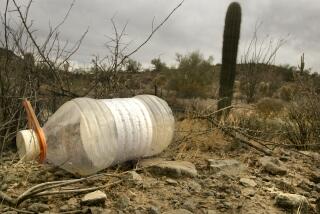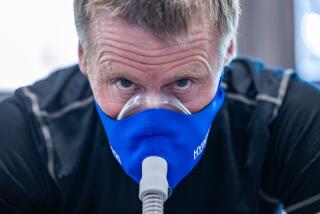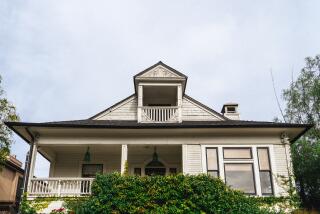A trek into the Atlas Mountains in Morocco
- Share via
You have to wonder whether it’s a setup when you’re in a Muslim country and someone asks, point-blank, “Are you lot drinkers?”
Despite the hooded djellaba he was wearing, John Horne, who was doing the asking, looked as though he had guzzled a few in his time, so I took a calculated risk and confirmed that yes, we lot were drinkers.
John is a Brit, a bespectacled, erudite, eccentric and highly amusing Yorkshireman who has spent the last 40 years circumnavigating the globe. He lived in Marrakech, working for a tour company, and he was about to join my two friends and me on a six-day hike in Morocco’s High Atlas Mountains.
“Right, then,” John said, visibly relieved. “When you’ve walked all day, by God, you really need a pop at night. Got to bring your own, though. No pubs up there.” John impressed us as a man who knew a lot about North Africa, so naturally we felt obliged to take his advice. We turned the car around and beat a hasty retreat to purchase rum and wine. Moroccan wine, in fact.
That we could buy locally produced wine easily in Marrakech but not in remote mountain villages exemplified the dichotomy that is Morocco. Cities such as Marrakech, which has a population of more than a million, are startlingly modern -- and the ban on the sale of alcohol to Muslims is not enforced. In rural areas, however, people live as they have for centuries: The beverage of choice is nothing stronger than mint tea.
My friends -- artist Susan Burks and photographer Kodiak Greenwood -- and I were in the country not only to exert ourselves in the Atlas Mountains but also to be among traditional Berber people. Apparently, they tolerate the drinking habits of nasrani (non-Muslims) and are used to them rocking up to their villages with their own mule-borne bars.
Unlike the Himalayas, the Atlas Mountains aren’t impressive from space. It’s said that they look like a poorly healed scar. But what they don’t achieve in height they make up in breadth, stretching 1,500 miles through Morocco, Algeria and Tunisia. In Morocco, they’re divided into three parts -- the Middle Atlas in the north, the High Atlas in the central-south and the Anti-Atlas as they taper into the Sahara Desert.
Jebel Toubkal, in the High Atlas, is North Africa’s loftiest peak at 13,671 feet. We would hike toward Toubkal, popular with peak baggers as a challenging overnight climb. But slackers that we were, we had chosen not to summit. We felt more inclined to spend time in Berber villages than shuffling upward in thin-aired privation.
After six days of hiking the still-plenty-precipitous parts of the High Atlas, we would end up at a luxury Kasbah hotel as a reward to ourselves. When planning the trip, I had searched for a tour company that knew the area from an off-the-beaten-path perspective and found New York-based Heritage Tours. Its staffers had hiked the routes themselves and offered unvarnished opinions.
I had pushed hard to sleep in Berber tents in the mountains, fancying it would be more authentic, but Michael Diamond of Heritage swiftly disabused me of that notion. “Your friends will want to kill you when you’re 10,000 feet up, it’s blizzarding, and you’re hunkered inside a tent,” he said. Snow in the High Atlas can arrive in October, when we were to be there. I conceded to small trekking lodges instead.
::
After a three-hour drive from Marrakech, we reached our trail head at Oukaimeden, a popular ski resort in winter but with the look of an abandoned Soviet mental institution in the fall. It’s a good spot to begin walking. Needing to spend the night, we made the mistake of staying at Hotel le Courchevel, which brought back memories of the creepy twins scene from “The Shining” (“Come play with us, Danny!”), with its vacant, gloomy and seemingly sinister hallways. Auberge Chez Juju, a small guesthouse, albeit with Spartan accommodations, is the better option. And the restaurant at Chez Juju serves unexpectedly excellent lasagna.
Mohammed “Calal” Bouchahoud, our mountain guide, joined us at dinner. This stately prince of a man is a Berber, the original, pre-Arab inhabitants of Morocco. They are typically short and mocha-skinned and often have green eyes. But Calal is tall, brown-eyed and dark-skinned, and he has a charisma that surrounds him like a force field. He is 44, speaks French, English, Arabic and Tashelhit (a Berber language), knows every inch of the Atlases and has ascended Toubkal more than 100 times.
Calal also had made a hajj, the pilgrimage to Mecca, the holiest city in Islam. In a country where the average annual income is $4,000, any Berber who can afford Mecca is a man oozing social standing. Wherever we went, from the tiniest village to a sizable town, everyone stopped to hail Calal. It was like taking a five-day hike with a spiritually inclined Fonzie.
The plan was to walk six to nine hours a day, our luggage and accouterments accompanying us on three stalwart mules driven by local muleteers. Without consulting Susan and Kodiak, Calal and I had conspired to take the more precipitous route up Jebel Oukaimeden, climbing from 8,600 to 10,800 feet in a matter of hours. The trail, or rather a ribbon of goat tracks, was straight up, switchbacks be damned. I am in my mid-40s and it was a firm but pleasurable challenge. Susan, who is in her 50s, later dubbed the mountain “Jebel I-hate-Amanda,” after her mantra with each breathless, jet-lagged step. Kodiak, in his late 20s, bounded ahead, camera in hand, pausing only to salute us from great heights. Calal floated upward as if every step took him closer to Allah. John, in his 60s, mumbled something about “ensuring the mules didn’t roll the rum” and took the flatter valley route with the muleteers.
Finally cresting the peak, I stopped to take in the view. The sky was brilliant, the air chilled and sparkling. Spread before me were the Atlases, one of the world’s great mountain ranges, layers of rock slanted sideways, stacked to the horizon in one direction and thinning into the smudge of the mighty Sahara in the other. It was a chest-swelling scene. Even Susan eventually admitted it.
Tachedirt, the highest and possibly darkest village in Morocco, was our first night’s destination. The educated and progressive king of Morocco, Mohammed VI, promised electricity to all when he took power in 1999, and he was true to his word: Tachedirt has lines strung and waiting. But nobody has figured out how to divvy up payment for the power, so the hamlet remains off the grid, illuminated at night by candles and oil lamps.
Berber women still cook over fire, grind flour on a stone wheel powered by a donkey, use machetes in the fields, do laundry in the river, hand-sew their clothes and use mules for transport. Electricity is not likely to change any of that overnight.
We lighted candles, dressed warmly and retired to our rooms to drink surprisingly decent Moroccan red and listen to John tell tales of his days with the British Ministry of Defense. Calling himself “The Uncivil Servant,” he had us chortling with stories of shooting his way out of Yemen, being threatened with beheading in Algeria -- somehow, he managed to make these incidents amusing -- and then chucking it all to become a long-haul tour guide, driving hippies across the Sahara in the 1970s. When we walked through villages, children followed him like a pied piper while he teased them in Arabic. “You Arab?” they’d ask, confused. “Nope,” he’d reply, “I’m David Beckham.”
::
With each day, the scenery became more striking and untouched. Our mules snaked up barren rock faces and along narrow mountain ledges, our bottles of booze clinking shamelessly.
After the severe rock of the peaks, the landscape dropped down and turned suddenly verdant, the path an arbor through fruit and nut trees. Flanks of valleys were terraced with stacked rock walls, some to keep goats in and others to keep them out of the neon green barley. Even the air took on a sylvan light. It was all so bucolic that it had a tranquilizing effect, and I was grateful that the only thought process required of me was to remember to put one foot in front of the other.
At lunchtime, we would round a corner and find that the muleteers had arranged a picnic beside the glinting waters of a mountain stream. There we would lounge; eat tuna salad, dates and khobz bread; drink mint tea; and take a siesta before hitting the trail again. It felt like a scene out of an F. Scott Fitzgerald book.
Occasionally, a Berber farmer would encounter us near a village and enthusiastically shepherd us into his home. This meant the wife had to drop her duties and scramble to make mint tea, remaining in the shadows of the low-ceiling house while the husband entertained us on rugs woven of old pieces of cloth. A large-eyed child would carry in the tea and the patriarch would make a ceremony of adding overpowering amounts of sugar (an expensive commodity) and expertly aiming the amber liquid into tiny tea glasses. He’d then walk us to the edge of town and wave us on our way.
Over five days, we hiked southwest from Oukaimeden to Tachedirt, Tachedirt to Imlil, Imlil to the Azzedine Valley and finally to Ouirgane, driving back to Imlil. Our nights were spent lying about, sipping illicit alcohol (that word, ironically, comes to us from the Arabic alkuhl, representing the essence or the spirit), listening to John’s James Bondian tales of global derring-do and feasting on couscous and tagine (slow cooked stews) meals.
Some of the guesthouses were fancier than others. Most had three to eight rooms, and all were comfortable and attractive, with excellent food.
Imlil, a buzzing metropolis of several hundred, is the launching spot for those not too lazy to ascend Jebel Toubkal. It’s reminiscent of Katmandu, but in miniature, the dirt streets populated with emaciated travelers sporting dreadlocks, ethnic tattoos and hand-loomed harem pants. It is also the home of the famed Kasbah du Toubkal, an old fort turned Berber hotel that sits above the town and draws a more upmarket crowd.
We stayed at Dar Imlil, a beautiful little hotel on the outskirts of town. It had great food, chic décor and the best view in the valley, so we were quite content to sit and watch the first snows fall on the mountains surrounding us.
To recover from our grueling Toubkal nonascent, we said goodbye to Calal and John and headed for Richard Branson’s Kasbah Tamadot in the Asni Valley, 20 miles from Imlil on a twisting road. Imagine a scene in which the parched and weary traveler arrives at a sultan’s court, a walled Shangri-La with fountains, rose gardens, petal-strewn reflection pools, carved doors, silk divans, stuffed dates on golden platters and, blessed day, not one, but three bars and a spa.
Branson, of Virgin Atlantic fame, discovered Tamadot while trying to fly around the world in a hot-air balloon. Actually, Branson’s mother, who had come to Morocco to cheer him on, discovered it while exploring the Atlases, telling her son that he must buy the enchanted fortress. So we have Eve Branson to thank for what is now one of the most sumptuous Virgin hotels.
It has a domed marble hammam, a spa, two pools, two restaurants, 18 palace-like rooms and six Berber tented suites. And so I finally got my Berber tent experience -- except that this one was heated and had a sitting room, a shower, a claw-foot bathtub, a dressing room, a plunge pool and a vast deck from which I could gaze up at Jebel Toubkal and admire the stoic die-hards who were huddled in their tents while a blizzard raged outside.
More to Read
Sign up for The Wild
We’ll help you find the best places to hike, bike and run, as well as the perfect silent spots for meditation and yoga.
You may occasionally receive promotional content from the Los Angeles Times.






